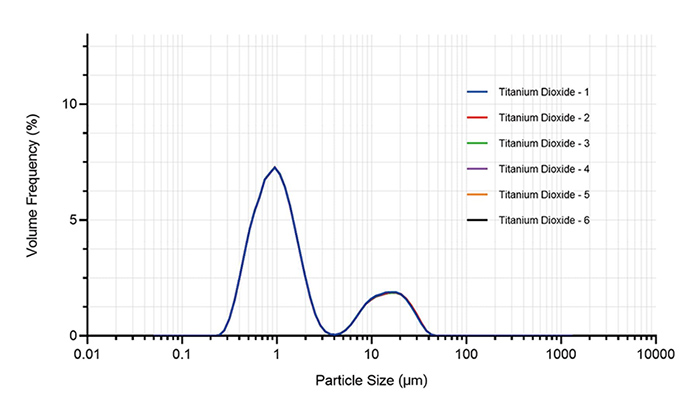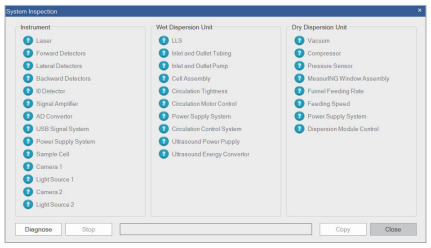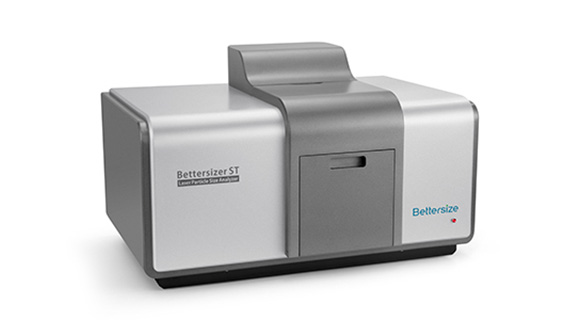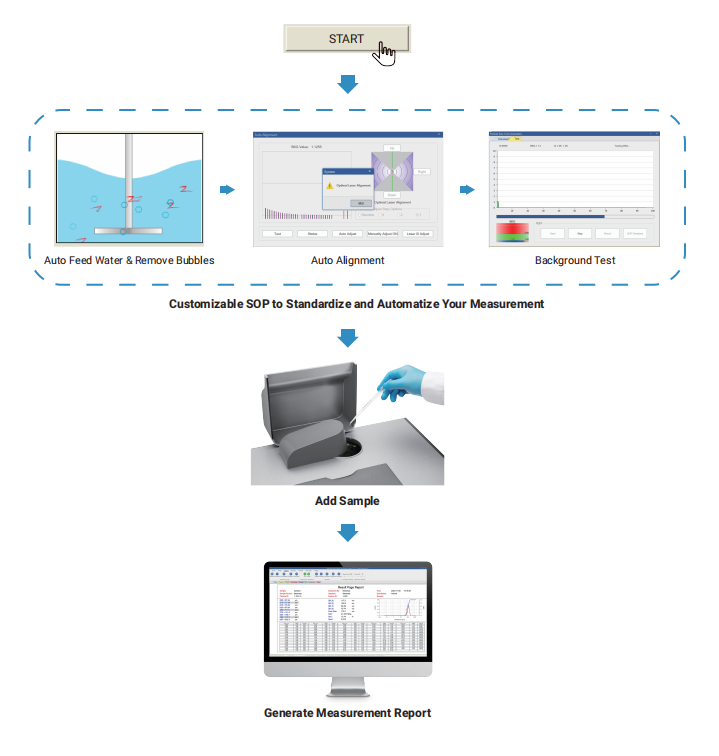Bettersizer ST
The Bettersizer ST is a fully automated and integrated particle size analyzer with a smart operation system by wet dispersing. Optimized for the industrial QC process, the Bettersizer ST provides stable and reliable testing results with minimum user intervention. The compact footprint saves valuable workspace for factories and laboratories.
Features and Benefits
- ● Dispersion type: Wet
- ● Size range: 0.1 - 1,000µm
- ● Robustness
- ● Ease-of-Use
- ● Cost-Efficiency
- ● Compact design
- ● Low maintenance
- ● Dual lens system
- ● Automatic alignment functionality
- ● Automatic measurement with SOP
Video
How to Install and Operate Bettersizer ST 
Bettersizer ST Self-Installation is Quick and Easy 
Learn How Bettersizer ST can Help with Your Quality Control in 2 Minutes 
Bettersizer ST | Demo (CaCO3 Sample) 
Bettersizer ST Overview | Laser Diffraction Particle Size Analyzer for QC 
Overview
Features
SOP
DLOS
Technology
Specification
Your One-Stop QC Tool
The Bettersizer ST is an automated laser diffraction particle size analyzer designed for industrial quality control. Its patented DLOS (Dual Lens Optical System) guarantees the instrument to provide consistent and reliable particle size distribution results. The SOP (Standard Operating Procedure) and automated analysis procedures are designed to help you save valuable time for quality inspection.
1. Excellent Accuracy
♦ Accuracy verification of standards
- Duke standard samples were measured separately by the Bettersizer ST laser particle sizer, showing the distribution peak in the correct position and narrow distribution with high accuracy.

- The red line is the nominal size range of standards ± 1.0%, and the black dots are the measured sizes. As shown in the figure, the measurement accuracy of Bettersizer ST laser particle sizer for standards is within 1%.

2. Outstanding Repeatability
Exceptional repeatability provided by Bettersizer ST laser particle sizer ensures the reliability of the results. Rapid measurements with consistent and reliable results can ease your workload on quality control.
♦ Excellent repeatability from
- Stability of signal transmission systems
- Efficient dispersion system
- Automatic alignment keeps the instrument always in optimum condition
- Signal acquiring rate up to 3500 times/second
♦ Repeatability tests
The outstanding repeatability of Bettersizer ST, demonstrated by the following two consecutive tests.
 |
 |
 |
 |
3. Ease Your Workload In All Aspects
The Bettersize software provides various functions that greatly reduce your workload.
1) Intuitive software
2) Intelligent data evaluation for quality control

3) Performance validation
With the independent Performance Validation function, the software can automatically generate reports that complies with ISO 13320 and pharmacopoeias.
4) System inspection
Diagnostic scan: System inspection checklist.
4. Cost-Efficiency & Robustness
1) Outstanding robustness
- Integrated casting of the bottom plate to protect the instrument
- Accurate measurements can be achieved even after a robustness test
- Long-life fiber semiconductor laser source
- Durable circulation tank with casted stainless steel
- Power-adjustable ultrasonic disperser with dry run protection
2) Compact design
- Save valuable workspace for factories and laboratories with an internal wet dispersion system
- The DLOS ensures result accuracy and reliability, while avoiding folding optics that are susceptible to misalignment
3) Simple maintenance
- Simple disassembly of sample cells allows a quick cleaning, which can be easily accessed without professional tools and excessive clean formulations
- Auto-cleaning function for the circulation tank eases the maintenance work greatly
- Auto-cleaning process can be easily customized in the software
4) Low cost of ownership
- Entry-level price for a laser particle size analyzer
- A measurement range that covers most applications can be achieved with DLOS without additional cost for a second laser source
Citations
- Bettersizer 2600
Functional redundancy as an indicator for evaluating functional diversity of macrobenthos under the mussel raft farm near Gouqi Island
DOI: 10.1016/j.aquaculture.2023.740024 Read ArticleZhejiang Ocean University | 2024Biological traits analysis (BTA) helps to evaluate the effects of different environmental variables on the traits-based functional composition of macrobenthos. However, research on functional traits of macrobenthos under mussel farming is limited. We investigated the spatial and temporal response of the benthic system in terms of taxonomic and functional diversity to environmental variables of farming and natural stressors resulting from suspended mussel farming near Gouqi Island of eastern China Sea. The functional traits of macrobenthic assemblages under mussel farming were characterized by “medium adult body size”, “vermiform body form”, “high flexibility”, “infauna”, “semi-motile”, “gonochoristic”, “surface deposit-feeders”, “carnivores”, “semi-motile burrowers”, and “tube-dwellers”. Functional redundancy was stable in response to mussel farming stresses among seasons, whereas species diversity showed efficient to evaluate natural variables. Functional diversity was significantly affected by farming stressors rather than natural variables, Further analysis using multivariate methods together with continuous monitoring were highlighted to evaluate the impacts of mussel farming. Our results reinforce the importance of macrobenthic species and functional traits analysis to evaluate human stresses driven impacts in offshore ecosystems. By analysing the environmental variables with different sources, independently, we concluded the main effects of human pressures on macrobenthic community. Such distinction could be particularly effective to isolate variable environmental descriptors and evaluate their effects on functional diversity, making the current approach promising for the evaluation of ecological effects of anthropogenic stressors in aquaculture areas. - Bettersizer 2600
Degradation characteristics and utilization strategies of a covalent bonded resin-based solid amine during capturing CO2 from flue gas
DOI: 10.1016/j.seppur.2023.125621 Read ArticleChina University of Petroleum | 2024In this study, various types of degradation as well as attrition which are possibly encountered in a circulating fluidized bed temperature swing adsorption (CFB-TSA) process, were conducted experimentally to evaluate the stability of a resin-based solid amine sorbent. Other characterizations methods, such as elemental analysis (EA), Fourier transform infrared spectroscopy (FTIR) etc. were applied to further reveal the degradation mechanisms. The results showed that thermal degradation occurs from 140–160 °C due to the decomposition of amine group. The CO2-induced degradation occurs from a higher temperature of 160–180 °C accompanied by the production of urea. Hydrothermal stability is good below 130 °C, but the ionic impurities in steam crystalized on particle surface can accelerate the degradation. Oxidative degradation is the most harmful, which starts at a lower temperature of 70–80 °C with the formation of aldehyde. The existence of H2O in atmosphere can alleviate the oxidative and CO2-induced degradations. The employed sorbent has a very low attrition index of 0.05, which is 1–2 orders lower than typical commercial fluidized bed catalysts. Based on the results of stability evaluation, some design suggestions for proper utilization of this sorbent or other similar resin-based sorbents have been provided in an industrial CFB-TSA process.
- Bettersizer 2600
De-branching of starch molecules enhanced the complexation with chitosan and its potential utilization for delivering hydrophobic compounds
DOI: 10.1016/j.foodhyd.2023.109498 Read ArticleShihezi University | 2024The current study aimed to prepare the complexes between debranched-waxy corn starch and chitosan polymers (DBS-CS), and then investigated their corresponding structural characteristics, rheological property and potent application in Pickering emulsion. The results indicated that the existence of chitosan significantly inhibited starch short-range molecular rearrangement for all DBS-CS samples, which was manipulated by both debranching treatment and chitosan content. Interestingly, this is the first study to reveal that the outstanding peak at 1.8 ppm in 1H NMR spectrum for sample DBS-CS was gradually shifted towards a lower-field region following an increased chitosan content. Moreover, the debranching treatment shifted the crystallinity pattern from A-type to B-type and the relative crystallinity of DBS-CS decreased gradually with the increased content of CS. All samples had a pseudoplastic fluid and shear-thinning behavior with an enhanced shear resistance following the complexation. The DBS-CS was applied in a Pickering emulsion for showing a greater emulsifying stability and a lower gel strength than native NS-CS prepared emulsion. Importantly, the encapsulation ability of curcumin in the DBS-CS emulsion was significantly improved, followed by an increase of 15.45% for its corresponding bioavailability compared to the control. Therefore, this study might highlight a potential carrier for delivering the bioactive substances in a green pattern. - Bettersizer 2600
Heat-induced aggregation behavior of wheat gluten after adding citrus pectin with different esterification degree
DOI: 10.1016/j.foodhyd.2023.109420 Read ArticleGansu Agricultural University | 2024Wheat gluten aggregation during heat treatment is beneficial to the final quality of gluten-based products. Exogenous pectin can affect gluten aggregation. However, the effect of pectin with different degrees of esterification on the heat-induced aggregation behavior of gluten and its possible mechanism are still unclear. Thus, the heat-induced aggregation behavior of gluten after adding pectin with different esterification degree was studied in this study. When the temperature was raised from 25 °C to 95 °C, pectin affected gluten aggregation and was related to the degree of esterification. Specifically, the results of rheological properties and particle size indicated that low-ester pectin improved the viscoelasticity of gluten and promoted gluten aggregation. Thermal properties revealed that enthalpy of gluten added with low-ester pectin (37%) increased from 92.96 J/g to 95.40 J/g during heating process. Structurally, the fluorescence intensity and surface hydrophobicity of gluten added with low-ester pectin (37%) were lower than those added with high-ester pectin (73%). In addition, low-ester pectin (37%) significantly increased the disulfide bond content (from 15.31 μmol/g to 18.06 μmol/g) and maintained β-sheet content of gluten compared with gluten alone at 95 °C, indicating that low-ester pectin was more likely to induce gluten aggregation. However, scanning electron microscope showed that the gluten added with low-ester pectin (46%) exhibited a denser network structure at 95 °C than that added with low-ester pectin (37%). These results will provide a theoretical base for the regulation of gluten aggregation and the quality of gluten-based products by pectin with different esterification degree.
- 1
- 2
- 3
- 4
- 5
- 6
- 84
Curated Resources
Testimonials


Related Particle Size Analyzer
-
Bettersizer S3 Plus
Particle Size and Shape Analyzer
Measurement range: 0.01 - 3,500μm (Laser System)
Measurement range: 2 - 3,500μm (Image System)
-
Bettersizer 2600
Laser Diffraction Particle Size Analyzer
Measurement range: 0.02 - 2,600μm (Wet dispersion)
Measurement range: 0.1 - 2,600μm (Dry dispersion)
Measurement range: 2 - 3,500μm (Dynamic imaging)
-
BT-Online1
Online Particle Size Analyzer
Dispersion type: Dry
Measurement range: 0.1 - 1,000μm
Accuracy: ≤1% (D50 of certified reference material)
-
BeScan Lab
Stability Analyzer
Particle size ranges from 10 nm to 1 mm
Volume fraction up to 95%
Compliance with ISO/TR 18811, 13097, 21357, 22107

















